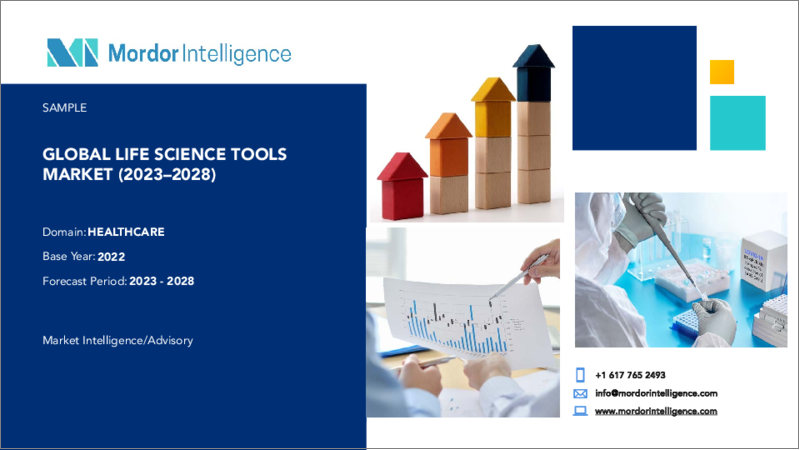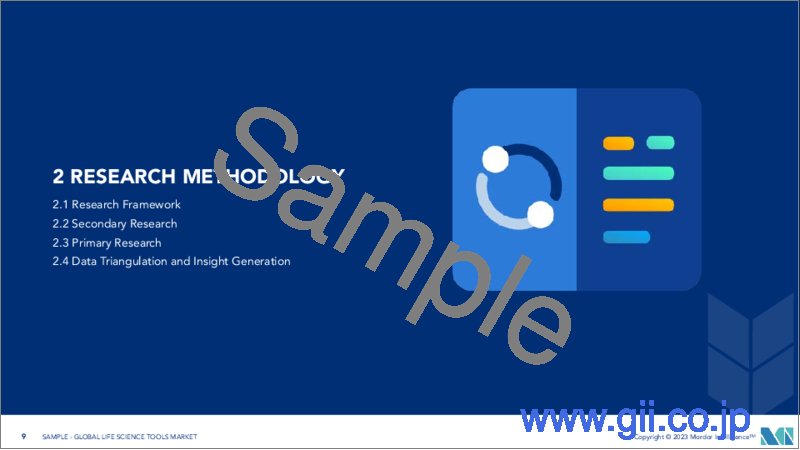|
|
市場調査レポート
商品コード
1197414
ライフサイエンスツール市場- 成長、動向、予測(2023年-2028年)Life Science Tools Market - Growth, Trends, and Forecasts (2023 - 2028) |
||||||
|
● お客様のご希望に応じて、既存データの加工や未掲載情報(例:国別セグメント)の追加などの対応が可能です。 詳細はお問い合わせください。 |
|||||||
| ライフサイエンスツール市場- 成長、動向、予測(2023年-2028年) |
|
出版日: 2023年01月23日
発行: Mordor Intelligence
ページ情報: 英文 120 Pages
納期: 2~3営業日
|
- 全表示
- 概要
- 目次
ライフサイエンスツール市場は、予測期間中にCAGR7.5%を記録すると予想されています。
世界的には、COVID-19の大流行がライフサイエンスツール市場の成長にプラスの影響を与え、診断薬の急速な開発、規制当局の迅速な承認、ウイルスの蔓延を抑制するための各国での流通量の増加などがありました。感染症の検出には、常にさまざまな診断手順が不可欠です。現在、COVID-19を検出するために、いくつかの分子アッセイとイムノアッセイが実施されています。しかし、パンデミックの余波を受けて、ライフサイエンス業界では、予期せぬ世界のパンデミックの負担に備えるための研究が活発になっています。例えば、2022年9月、WHOは、ライフサイエンスツールの責任ある使用のためのガイダンスフレームワークを発表しました。このフレームワークは、明確な利益をもたらすが、悪用されると人間や他の動物、農業、環境に害を及ぼす可能性があるデュアルユース研究について、リスクを軽減し、安全に管理するよう指導者やその他の利害関係者に呼びかけています。したがって、ライフサイエンスへの注目が高まる中、研究される市場は今後数年間で大きく成長すると予想されます。
ゲノム技術は、様々な疾病を理解し、新しい診断テストや手順の開発に貢献するため、世界的にますます利用されるようになっており、市場の成長を後押ししています。例えば、2022年9月、Becton, Dickinson, and Company(BD)とCerTest Biotecは、米国と世界市場向けにサルポックスウイルス用の新しい分子ポリメラーゼ連鎖反応(PCR)アッセイの商業的販売を開始しました。同社は、このPCRアッセイは研究目的にのみ使用できるとしています。このような新しい試薬の上市により、市場は予測期間中に力強い成長を遂げると予想されます。
さらに、シーケンス技術、クロマトグラフィー法、質量分析などに関連する技術的進歩により、病院、研究所、診断研究所でのこれらのツールの採用が増加しました。WHO 2021 Factsheetによると、68万人がHIV関連の原因で死亡し、150万人がHIVを獲得しています。したがって、患者数の多さが治療需要を押し上げ、いくつかの感染症の特定、診断、進行のモニタリングのためのライフサイエンスツールの使用をさらに増加させるでしょう。
さらに、さまざまな感染症に対する診断テストの需要が高まっていることから、対象者を診断するためのライフサイエンスツールの開発に拍車がかかり、予測期間中の市場全体の成長を後押しするものと思われます。
ライフサイエンスツールの市場動向
分離技術のライフサイエンスツールは、予測期間中に健全な成長率を達成することが予測される
分離技術分野の主な促進要因としては、医薬品研究開発への投資拡大やライフサイエンス業界におけるクロマトグラフィー技術の採用拡大などが挙げられます。
世界的には、COVID-19の大流行がライフサイエンス機器市場に好影響を与えました。COVID-19の発生により疾病が増加したため、その後の研究開発活動が活発化しました。創薬への投資の増加は、分離技術分野の成長を促進することが期待されます。例えば、2022年5月、Cipla社はインドでCOVID-19 PCRキットの商品化を発表しました。このリアルタイムRT-PCR検査キットは、インド医学研究評議会(ICMR)公認のセンターで検証されています。
分離技術には、免疫沈降法、クロマトグラフィー技術、自動精製システムなどがあり、COVID-19の診断と治療に役立っています。例えば、Indian Journal of Medical Research 2021によると、インド北部の三次医療教育病院で、COVID-19の診断における免疫測定ベースのクロマトグラフィー迅速検査を評価する研究が行われました。その結果、イムノアッセイに基づく迅速クロマトグラフィー検査は、COVID-19患者の迅速な検出、分離、治療に役立つことが分かりました。
さらに、クロマトグラフィー技術に付随するいくつかの利点から、この技術はいくつかの産業で広く採用されています。大型カラムの必要性を減らすなどの利点は、生産プロセスの効率と生産性を向上させます。このように、複数の分離技術の採用が各分野で進むことで、ライフサイエンスツールの需要が高まり、セグメントの成長が促進されるでしょう。
世界の感染症の流行は、ライフサイエンスツールの採用を促進します。例えば、WHO 2021 Factsheetによると、2021年には150万人が結核で死亡し、世界中で推定1000万人が結核に罹患しています。近年は着実に減少しています。しかし、まだかなり高い水準にあります。
したがって、上記の要因が予測期間中のセグメント成長を促進することが期待されます。
予測期間中、北米が重要な市場シェアを占めると予想される
北米の市場成長を促進する主な要因としては、ゲノム手術数の増加、研究開発費の増加、多数の大手企業の存在、バイオ医薬品企業間での採用拡大、製品の上市、技術の進歩などが挙げられます。
米国でCOVID-19が発生したことにより、診断手順が増加し、市場成長につながりました。このように、新しい技術を用いた診断法はCOVID-19の管理に有益であることが証明されており、ライフサイエンス機器市場の成長を促進しています。
米国のバイオ医薬品業界は、合成ワクチン、ナノ抗体、rDNA、融合タンパク質、免疫複合体、可溶性受容体、免疫治療薬などの新しい製品タイプを含むように大きく拡大しています。製薬・バイオ医薬品業界によるライフサイエンス・ツール、研究、学術への研究開発投資の増加が、市場を牽引すると予想されます。
例えば、米国研究製薬工業協会(PhRMA)によると、米国のバイオ医薬品業界は新薬開発において世界のリーダーの一角を担っています。バイオ医薬品・製薬業界全体の研究開発(R&D)投資額は、前年の約830億米ドルに対し、2021年には約911億米ドルに上ると推定されています。
さらに、新規ドラッグデリバリーシステムの採用の増加や感染症患者の増加により、予測期間中、同地域のライフサイエンスツール市場の活性化が期待されます。
ライフサイエンスツール市場の競合他社分析
ライフサイエンスツール市場の競争は緩やかです。市場参加者は、製品の承認や上市、買収、パートナーシップ、契約などの戦略を採用しています。市場プレイヤーの中には、Becton, Dickinson and Company、Agilent Technologies、Illumina Inc.、Thermo Fisher Scientific Inc.、F. Hoffmann-La Roche Ltd、Merck KGaA、GE Healthcare、Bruker QIAGENなどが挙げられます。
その他の特典
- エクセル形式の市場予測(ME)シート
- アナリストによる3ヶ月間のサポート
目次
第1章 イントロダクション
- 調査の前提条件と市場の定義
- 調査対象範囲
第2章 調査手法
第3章 エグゼクティブサマリー
第4章 市場力学
- 市場概要
- 市場促進要因
- バイオ医薬品の需要増とライフサイエンス研究への資金提供の増加
- ターゲットとなる感染症や遺伝性疾患の発生率の増加
- 市場抑制要因
- 機器の高コスト
- ポーターのファイブフォース分析
- 新規参入業者の脅威
- 買い手/消費者の交渉力
- 供給企業の交渉力
- 代替品の脅威
- 競争企業間の敵対関係
第5章 市場セグメンテーション(金額ベース市場規模:百万米ドル)
- タイプ別
- 機器
- 消耗品
- サービス
- 技術別
- PCRおよびqPCR
- サンガーシークエンス
- 分離技術
- フローサイトメトリー
- 核酸マイクロアレイ
- 質量分析
- その他の技術
- アプリケーション別
- プロテオミクス技術
- ゲノム技術
- セルバイオロジー技術
- その他のアプリケーション
- エンドユーザー別
- 調査研究機関
- 診断研究機関
- その他のエンドユーザー
- 地域別
- 北米
- 米国
- カナダ
- メキシコ
- 欧州
- ドイツ
- 英国
- フランス
- イタリア
- スペイン
- その他の欧州地域
- アジア太平洋地域
- 中国
- 日本
- インド
- オーストラリア
- 韓国
- その他アジア太平洋地域
- 中東地域
- GCC
- 南アフリカ
- その他の中東地域
- 南米地域
- ブラジル
- アルゼンチン
- その他の南米地域
- 北米
第6章 競合情勢
- 企業プロファイル
- Becton, Dickinson and Company
- Agilent Technologies Inc.
- Illumina Inc.
- Thermo Fisher Scientific Inc.
- F. Hoffmann-La Roche Ltd
- Bio-Rad Laboratories Inc.
- Merck KGaA
- GE Healthcare
- Bruker Corporation
- Qiagen NV
- Danaher Corporation
- Abbott Laboratories Inc.
第7章 市場機会と今後の動向
The life science tools market is expected to record a CAGR of 7.5% during the forecast period.
Globally, the COVID-19 pandemic positively impacted the growth of the life science tools market with the rapid development of diagnostics, fast-tracked regulatory clearances, and increased distribution in various countries to help curb the spread of the virus. Various diagnostic procedures have always been essential in the detection of infectious diseases. Currently, several molecular assays and immunoassays are in place to detect COVID-19. However, in the aftermath of the pandemic, there has been increased research in the life sciences industry to prepare for any unexpected global pandemic burden. For instance, in September 2022, the WHO issued a guidance framework for the responsible use of life science tools. The Framework calls on leaders and other stakeholders to mitigate risks and safely govern dual-use research, which has a clear benefit but can be misused to harm humans, other animals, agriculture, and the environment. Hence, with the increasing focus on life science, the market studied is expected to grow significantly in the coming years.
Genomic technologies are increasingly being used globally to understand and contribute to developing new diagnostic tests or procedures for various diseases, boosting the market's growth. For instance, in September 2022, Becton, Dickinson, and Company (BD) and CerTest Biotec commercially launched their new molecular polymerase chain reaction (PCR) assay for the monkeypox virus for the US and global markets. The company has stated that this PCR assay will only be available for research purposes. With such new launches, the market is expected to witness strong growth over the forecast period.
Furthermore, technological advancements associated with sequencing technologies, chromatography methods, mass spectrometry, and other products led to the increasing adoption of these tools in hospitals, research labs, and diagnostic laboratories. According to the WHO 2021 Factsheet, 680,000 people died from HIV-related causes, and 1.5 million people acquired HIV. Thus, a high patient population will boost the demand for treatment and further increase the use of life sciences tools for identifying, diagnosing, and monitoring the progression of several infectious diseases.
Furthermore, the rising demand for diagnostic tests for a variety of infectious diseases will spur the development of life science tools for diagnosing the target population, propelling overall market growth over the forecast period.
Life Science Tools Market Trends
Life Science Tools in Separation Technologies is Estimated to Witness a Healthy Growth Rate Over the Forecast Period
The major factors driving the separation technologies segment include growing investments in pharmaceutical R&D and the increasing adoption of chromatography technologies by the life sciences industries.
Globally, the COVID-19 pandemic positively impacted the life science instruments market. The outbreak of COVID-19 resulted in an increased number of diseases, which led to a subsequent increase in research and development activities. Increasing investment in drug discovery is expected to fuel the growth of the separation technology segment. For example, in May 2022, Cipla announced the commercialization of its COVID-19 PCR kit in India. The real-time RT-PCR test kit has been validated by an Indian Council of Medical Research (ICMR)-approved center.
Separation technologies include immunoprecipitation, chromatographic techniques, automated purification systems, and others that aid in diagnosing and treating COVID-19. For example, according to the Indian Journal of Medical Research 2021, a study was conducted in a tertiary care teaching hospital in northern India to assess a rapid immunoassay-based chromatographic test in the diagnosis of COVID-19. The results of the study showed that immunoassay-based rapid chromatographic tests can help in the rapid detection, isolation, and treatment of patients with COVID-19.
In addition, this technology is widely adopted by several industries due to several advantages associated with chromatography technology. Benefits such as reducing the need for large columns increase the efficiency and productivity of the production process. Thus, increased adoption of multiple separation technologies across sectors would increase the demand for life science tools and drive segment growth.
The increasing prevalence of infectious diseases worldwide will encourage the adoption of life science tools. For example, according to the WHO 2021 Factsheet, 1.5 million people died of tuberculosis in 2021, and an estimated 10 million people contracted tuberculosis (TB) worldwide. It has been steadily declining in recent years. However, it is still at a much higher level.
Thus, the above-mentioned factors are expected to drive segment growth over the forecast period.
North America is Expected to Hold a Significant Market Share over the Forecast Period
The major factors driving market growth in North America include the rising number of genomic procedures, increasing research and development expenditure, the presence of a large number of major players, growing adoption among biopharmaceutical companies, product launches, and technological advancements.
With the outbreak of COVID-19 in the United States, there has been an increase in the number of diagnostic procedures, leading to market growth. Thus, diagnostic procedures with new technologies have proven beneficial in managing COVID-19 and are driving the growth of the life sciences instruments market.
The biopharmaceutical industry in the United States has expanded significantly to include new product types such as synthetic vaccines, nanoantibodies, rDNA, fusion proteins, immunoconjugates, soluble receptors, and immunotherapeutics. The pharmaceutical and biopharmaceutical industries' increased R&D investment in life science tools, research, and academics is expected to drive the market.
For example, according to the Pharmaceutical Research and Manufacturers of America (PhRMA), the US biopharmaceutical industry is one of the world leaders in new drug development. The entire biopharmaceutical and pharmaceutical industry invested an estimated USD 91.1 billion in research and development (R&D) in 2021, compared to about USD 83 billion invested in research and development (R&D) in the previous year.
Furthermore, the increasing adoption of novel drug delivery systems and the rising prevalence of infectious disease cases are expected to fuel the life science tools market in the region over the forecast period.
Life Science Tools Market Competitor Analysis
The life science tools market is moderately competitive. The market players adopted strategies such as product approval and launches, acquisitions, partnerships, and agreements. Some of the market players include Becton, Dickinson and Company, Agilent Technologies, Illumina Inc., Thermo Fisher Scientific Inc., F. Hoffmann-La Roche Ltd, Merck KGaA, GE Healthcare, and Bruker QIAGEN.
Additional Benefits:
- The market estimate (ME) sheet in Excel format
- 3 months of analyst support
TABLE OF CONTENTS
1 INTRODUCTION
- 1.1 Study Assumptions and Market Definition
- 1.2 Scope of the Study
2 RESEARCH METHODOLOGY
3 EXECUTIVE SUMMARY
4 MARKET DYNAMICS
- 4.1 Market Overview
- 4.2 Market Drivers
- 4.2.1 Rise in Demand for Biopharmaceuticals and Increasing Funding for Life Science Research
- 4.2.2 Rising Incidence of Target Infectious Diseases and Genetic Disorders
- 4.3 Market Restraints
- 4.3.1 High Cost of Instruments
- 4.4 Porter's Five Forces Analysis
- 4.4.1 Threat of New Entrants
- 4.4.2 Bargaining Power of Buyers/Consumers
- 4.4.3 Bargaining Power of Suppliers
- 4.4.4 Threat of Substitute Products
- 4.4.5 Intensity of Competitive Rivalry
5 MARKET SEGMENTATION (Market Size by Value - USD million)
- 5.1 By Type
- 5.1.1 Instruments
- 5.1.2 Consumables
- 5.1.3 Services
- 5.2 By Technology
- 5.2.1 PCR and qPCR
- 5.2.2 Sanger Sequencing
- 5.2.3 Separation Technologies
- 5.2.4 Flow Cytometry
- 5.2.5 Nucleic Acid Microarray
- 5.2.6 Mass Spectrometry
- 5.2.7 Other Technologies
- 5.3 By Application
- 5.3.1 Proteomics Technology
- 5.3.2 Genomic Technology
- 5.3.3 Cell Biology Technology
- 5.3.4 Other Applications
- 5.4 By End User
- 5.4.1 Research Laboratories
- 5.4.2 Diagnostic Laboratories
- 5.4.3 Other End Users
- 5.5 Geography
- 5.5.1 North America
- 5.5.1.1 United States
- 5.5.1.2 Canada
- 5.5.1.3 Mexico
- 5.5.2 Europe
- 5.5.2.1 Germany
- 5.5.2.2 United Kingdom
- 5.5.2.3 France
- 5.5.2.4 Italy
- 5.5.2.5 Spain
- 5.5.2.6 Rest of Europe
- 5.5.3 Asia-Pacific
- 5.5.3.1 China
- 5.5.3.2 Japan
- 5.5.3.3 India
- 5.5.3.4 Australia
- 5.5.3.5 South Korea
- 5.5.3.6 Rest of Asia-Pacific
- 5.5.4 Middle East
- 5.5.4.1 GCC
- 5.5.4.2 South Africa
- 5.5.4.3 Rest of Middle East
- 5.5.5 South America
- 5.5.5.1 Brazil
- 5.5.5.2 Argentina
- 5.5.5.3 Rest of South America
- 5.5.1 North America
6 COMPETITIVE LANDSCAPE
- 6.1 Company Profiles
- 6.1.1 Becton, Dickinson and Company
- 6.1.2 Agilent Technologies Inc.
- 6.1.3 Illumina Inc.
- 6.1.4 Thermo Fisher Scientific Inc.
- 6.1.5 F. Hoffmann-La Roche Ltd
- 6.1.6 Bio-Rad Laboratories Inc.
- 6.1.7 Merck KGaA
- 6.1.8 GE Healthcare
- 6.1.9 Bruker Corporation
- 6.1.10 Qiagen NV
- 6.1.11 Danaher Corporation
- 6.1.12 Abbott Laboratories Inc.




